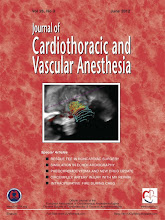Feroze Mahmood, MD
Madhav Swaminathan, MD
Section Editors
Madhav Swaminathan, MD
Section Editors
Coronary Artery Bypass Graft Surgery and Moderate Aortic Stenosis: When To Leave Well Enough Alone
Andrea Xavier, MD, Jason Erlich, MD, and Adam B. Lerner, MD
AN 84-YEAR-OLD man with a history of coronary artery disease (CAD) presented with unstable angina. The patient had a history of percutaneous transluminal coronary angioplasty of the circumflex artery 12 years prior but now had increasing angina, increasing dyspnea on exertion, and fatigue. The patient underwent cardiac catheterization that showed severe 3-vessel CAD, normal biventricular systolic function with an ejection fraction of 61%, mild aortic stenosis with an aortic valve area (AVA) of 1.6 cm2 with a maximum transvalvular gradient of 32 mmHg, and trace aortic regurgitation.
The patient’s past medical history was notable for hypertension, non–insulin-dependent diabetes mellitus, chronic renal insufficiency (creatinine of 1.6 mg/dL), hypercholesterolemia, and a Schatzki ring for which he had undergone esophageal dilation several years earlier. His medications included simvastatin, lisinopril, atenolol, hydrochlorothiazide, terazosin, glipizide, and aspirin. The patient was scheduled for coronary artery bypass graft surgery.
On arrival to the preoperative unit, the patient was in no distress with a blood pressure of 160/70 mmHg and a heart rate of 68 beats/min. He was 72 inches tall with a weight of 90 kg. His preoperative laboratory workup was unremarkable. His electrocardiogram showed a sinus rhythm with occasional premature atrial beats and a first-degree atrioventricular conduction
delay. He was taken to the operating room and underwent an uneventful placement of appropriate monitoring.
INTRAOPERATIVE TRANSESOPHAGEAL ECHOCARDIOGRAPHIC EXAMINATION
After the induction of anesthesia, a transesophageal echocardiographic probe was passed without difficulty. The transesophageal echocardiographic examination was performed with an IE-33 ultrasound system with an OMNI-III TEE probe(Philips Medical Systems, Andover, MA).
FINDINGS
Findings included the following: (1) a hyperdynamic leftventricle with an ejection fraction estimated at 75%, (2) mildto-moderate thickening and calcification of the 3 aortic valve leaflets (Fig 1), (3) a mild-to-moderate decrease in aortic valve leaflet mobility, (4) an instantaneous peak gradient of 28
Fig 1. (A) A midesophageal short-axis view of the aortic valve from the pre–cardiopulmonary bypass transesophageal echocardiographic examination. The 3 aortic valve leaflets show mild-to-moderate thickening and calcification as well as a mild-to-moderate decrease in leaflet excursion. (B) A midesophageal long-axis view of the aortic valve withcolor Doppler interrogation reveals color aliasing consistent with turbulent flow through a narrowed aortic valve orifice.
Fig 2. The velocity time profile of blood flow through the aortic valve generated with continuous-wave Doppler interrogation from the deep transgastric window. Peak and mean pressure gradients across the aortic valve are shown.
mmHg and a mean gradient of 18 mmHg across the aortic valve at a cardiac output of 4.5 L/min (Fig 2), (5) AVA calculated by the use of the continuity equation of 1.2 cm2, (6) trace aortic
insufficiency, and (7) trace mitral regurgitation (Figs 1 and 2 and Video).
ECHOCARDIOGRAPHIC CHALLENGES
The AVA calculated intraoperatively corresponds to moderate aortic stenosis that had been diagnosed as mild stenosis preoperatively. This potential increase in the grade of severity suggests the consideration of adding an aortic valve replacement to the scheduled coronary artery bypass graft procedure. Why is there a discrepancy in the measurements of AVA? Is the measurement of AVA using continuity correct? What can the authors do to confirm the measurement? Are there other echocardiographic findings that the authors can use to help make a decision on what to do for this patient?
CONFOUNDING VARIABLES
Symptoms are an important trigger in the decision tree for the management of aortic stenosis and valve replacement. Are the patient’s symptoms from CAD or aortic stenosis? Adding an aortic valve replacement adds risk to this procedure. Do the risks outweigh the benefits in this patient? The rate of progression of aortic stenosis varies from patient to patient and can impact the decision-making process. Can the authors get some estimate of this rate in the present patient?
THE AUTHORS’ DECISION
After careful consideration, the authors decided not to perform an aortic valve replacement because they felt that the risk of adding in aortic valve replacement was too high given the patient’s age and comorbidities. They felt that mild-to-moderate thickening and calcification of leaflets portended a slower progression of stenosis, and they felt that the patient’s life expectancy was such that he would likely never become symptomatic from aortic stenosis.



